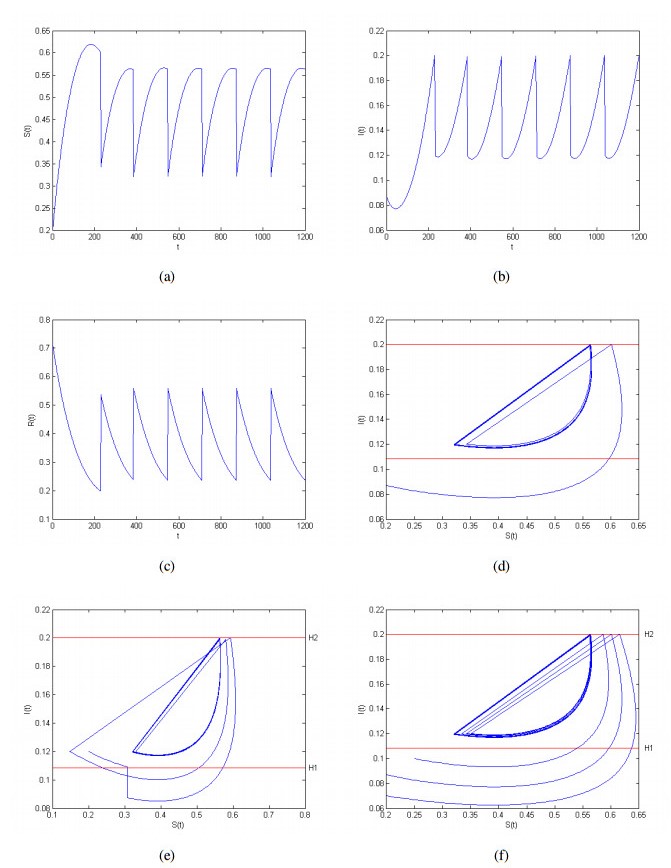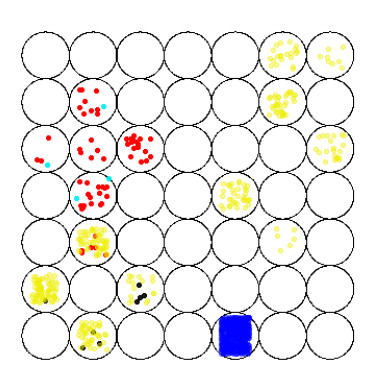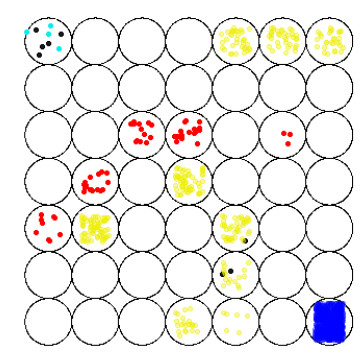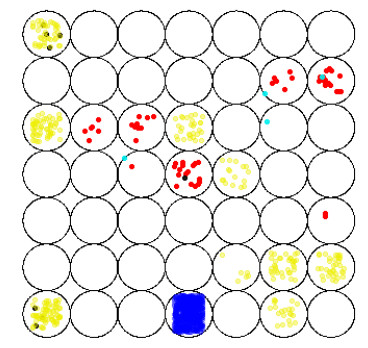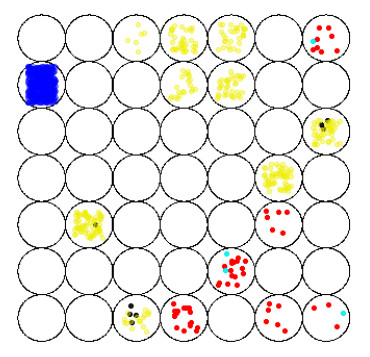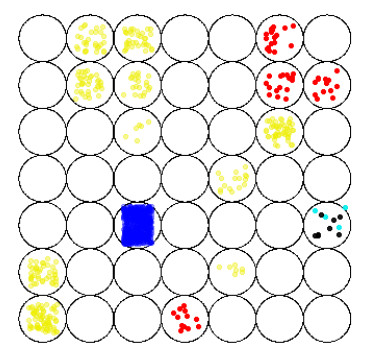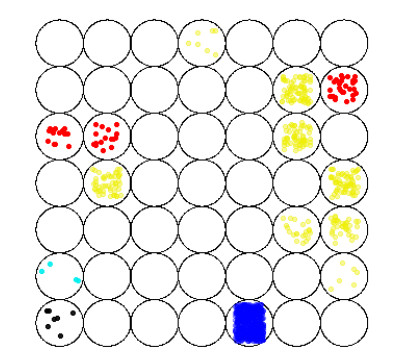1.
Introduction
It's well-known that infectious diseases are usually transmitted by virtue of various different mechanisms, for example, by person to person interactions, by insect vectors or via vertical transmission from parents to their unborn offspring as well. Unfortunately but objectively, the modelling dynamics of such disease transmission could be very complicated; and therefore, the development of reasonable strategies for controlling and preventing the spread of these diseases requires much appropriate mathematical analysis [1]. Through investigating related documents, we find that many diseases will transfer to new born offspring from an infectious parent, such as hepatitis B, herpes simplex, rubella, tuberculosis and most notoriously AIDS [1,2,3,4]. Hence, with the transmission character of these infectious diseases considered, the vertical transmission has important research significance. Over the past few years, the studies of epidemic models in which vertical transmission was involved have become some of the most relevant topics in the mathematical theory of epidemiology [1,2,4,5,6,7,8] and some of those have largely been motivated by the works of Busenberg and Cooke [7,8]. In those works, the transmission of Keystone virus in the mosquito Aedes atlanticus and of Rickettsia rickettsii in the tick Dermacentor andersoni were modeled with vertical transmission being considered, since both of these infections could be transmitted vertically from an infective parent to newborn offspring as well as horizontally via direct or indirect contacts with infected individuals. The work on a vertical infection transmission model has made certain progress; for the latest work on this topic, please refer to [9,10].
In recent decades, with the pollution and destruction of the ecological environment or for certain unknown reasons, some viruses that had been controlled or even disappeared in the past have recovered and spread all over the world again. Therefore, the control of infectious diseases still has been relevant in many interdisciplinary fields. Of all known and conventional strategies, the most efficient ways to eliminate or control infectious diseases are still immunization before the onset and effective medical care after the onset. The standard conventional approach is always constant vaccination or uniform treatment, as we can see more details in [11]. Nevertheless, when the economic costs and the side effects of the medications are both taken into consideration, particularly for infants, it is obviously both expensive and potentially harmful to implement medications for such a large population coverage. In view of the above reasons, in the actual situation, we naturally prefer to use the impulsive control strategy, which is easier to manipulate, and the relative expense can be reduced to a certain extent.
The theoretical research on pulse control strategy, which was first introduced by Agur and coauthors in [1], has become an important topic in mathematical biology and mathematical epidemiology in recent decades, attracting the research interests of many researchers [12,13,14,15,16,17]. Especially, the theory of an epidemic model concerning vertical transmission with pulse control at fixed times has been deeply investigated [18,19]. Song [16] discussed an SIR epidemic model with vertical transmission and impulsive vaccination which may undergo inherent oscillation and acquired conditions about the existence and global asymptotic stability of the positive disease-free periodic solution. Liu et al. [17] investigated an SIR epidemic model with a saturated infectious force and vertical transmission, and they carried out three different vaccination and treatment strategies. In recent years, Covid-19 has become a global epidemic, and there are also vaccination and treatment strategies against Covid-19 [20,21]. By comparing these strategies, they draw the conclusion that PTPVS (Pulse Treatment and Pulse Vaccination Strategies) behaved much better in the elimination and control of the disease than CTPVS (Continuous Treatment and Pulse Vaccination Strategies).
As previously analyzed, notwithstanding that a fixed-time pulse control strategy is widely performed in practice, a considerable portion of data shows that it has some defects, regardless of the effect of the strategy on preventing the spread of certain infectious diseases and the cost of medication, particularly, for the infectious diseases with vertical transmission, such as AIDS, hepatitis B and so on. For example, in the case of large infected population and rehabilitation are extremely urgent, but vaccination and treatment are not performed for it is not the fixed-time. In this regard, a natural idea is to vaccinate and treat when the observed infected population reaches a certain threshold size; in essence, it is based on the state feedback control strategy method. This state pulse is obviously more suitable and reasonable for disease control.
Due to its low cost, high efficiency and practicality, the control strategy with the state-dependent impulsive feedback has demonstrated applications in many seemingly different and widespread fields, especially in science and engineering. Especially, in the ecological surroundings, the control measures (catching, poisoning, releasing the natural predator, harvesting, etc.) are taken only when the amount of species reaches a threshold value, rather than the usual pulse fixed-time control strategy. Many papers have been devoted to the analysis of describing impulsive differential equations models with state-dependent effects. Tang et al. [18,19,22], Jiang et al. [23,24], Zhao et al. [25] and Nie et al. [26,27,28] considered various predator-prey models with state-dependent impulsive effects by poisoning the prey or releasing the predator, and they analyzed the existence and the stability of positive order-k (k≥3) period solutions. Particularly, Nie et al. [29,30,31] introduced the epidemic model with state-dependent pulse control and considered the existence and stability of positive order-1 or order-2 periodic solutions by using the Poincarˊemap, the differential inequality and the analogue of the Poincarˊe criterion. Moreover, they showed that there is no positive order-k (k≥3) periodic solutions. For more studies on state-dependent pulse control, we suggest that the readers refer to [32,33,34,35].
Motivated by the above considerations and the dynamic behavior of infectious diseases, in this paper, we will consider an SIR model in which vertical transmission and two state-dependent pulse effects are involved. In the next section, we put forward this SIR model and two Poincarˊemaps, as well as some basic definitions as preliminaries. Next, the foundational dynamic behaviors of our model, including the existence and stability of equilibrium are illustrated. By using the Poincarˊemap, the analogue of the Poincarˊe criterion and the method of qualitative analysis, the existence and the stability of the positive periodic solution of the SIR model are studied in Section 3. Simulations by virtue of MATLAB are given in Section 4, illustrating the applicability of our main results to the models studied. At last, we give some conclusions and map out directions for future work.
2.
Model formulation and preliminaries
We consider an epidemic in a rather closed environment, for instance, in a university, where the total population almost stays constant in a short period, that is, the natural birth rate equals the mortality rate. In a closed environment, an ordinary SIR epidemic model with vertical transmission is of the following form:
where μ is the natural birth (and also natural death) rate, β is the transmission rate of disease when the susceptible contact the infectious, δ(0≤δ≤1) is the proportion of uninfected offspring from infectious mothers, and γ is the recovery rate. All these parameters are positive constants. The total population size is normalized to one, i.e., S(t)+I(t)+R(t) = 1. About the SIR model, there is also some new research. For example, [36] discussed Optimal control of the SIR model, which is different from our work, since we will study pulse vaccination and treatment problems.
According to the simple dynamics analysis of the model (2.1), we get the following theorem.
Theorem 2.1. If the basic reproduction number ℜ0=βδμ+γ<1, then the disease-free equilibrium P0(1,0,0) of System (2.1) is globally asymptotically stable. However, for ℜ0>1, there exists an unstable disease-free equilibrium P0 and an unique endemic equilibrium P∗(S∗,I∗,R∗), which is globally asymptotically stable, where S∗=δμ+γβ,I∗=μ(β−δμ−γ)β(γ+μ),R∗=γ(β−δμ−γ)β(γ+μ).
In practice, considering the impact of the economy and the traits of infectious diseases, a pulse state feedback control strategy for infectious diseases is often proposed, rather than the usual continuous control or fixed-time pulse control strategy. When the amount of infected individuals is few, taking into account secondary actions of the medications, we hope that treatment is taken only for the infectious. On the other hand, when the infectious diseases have outbreaks, thinking about the effective control, we hope both vaccination and treatment are taken. Hereby, the control strategy is based on the following assumptions.
(A1) When the quantity of infected individuals reaches the first hazardous threshold value H1, where 0<H1<1−S∗, and the quantity of susceptible S<S∗=δμ+γβ at the time ti(H1)(i∈N+), only treatment is taken. The quantities of infectious and recovered suddenly turn to (1−m)I(ti(H1)) and R(t)+mI(ti(H1)), where m∈(0,1) is the proportion of the infectious cured at ti, which is called the pulse cure rate, respectively.
(A2) When the quantity of infected individuals reaches the second hazardous threshold value H2, where 0<H2<1−S∗ and H2>H1, and the quantity of susceptibles S≥S∗=δμ+γβ at the time ti(H2)(i∈N+), vaccination and medication are taken. The quantities of susceptible, infectious and recovered abruptly turn to (1−q)S(ti(H2)), (1−p)I(ti(H2)) and R(ti(H2))+pI(ti(H2))+qS(ti(H2)), respectively, where q,p∈(0,1) are the proportions of the susceptible vaccinated and the infectious cured successfully at ti, which are called the pulse vaccination rate and the pulse cure rate. According to the practical significance of the integrated control model, the condition: H1<(1−p)H2<H2<I∗ is always given as such.
According to assumptions (A1) and (A2), a control model of vertical transmission of disease is proposed, which is described by the following ordinary differential equations with two state-dependent pulse controls:
We assume, throughout this paper, that ℜ0=βδμ+γ>1. That is to say, System (2.2) without pulse effects has unique globally asymptotically stable equilibrium P∗(S∗,I∗,R∗). Set R+=(0,+∞), based on the biological background of System (2.2), and we only need to consider the region
Lemma 2.1. Suppose that (S,I,R) is a solution of System (2.2) which starts from the point (S(t0),I(t0),R(t0))∈R3+. Then, R3+ is positively invariant.
Proof. For any initial value (S(t0),I(t0),R(t0))∈R3+, we discuss all possible cases by the relation of the solution (S,I,R) to the lines L1:I=H1 and L2:I=H2, as follows.
Case 1: The solution (S,I,R) intersects with L1 finitely, while it intersects with L2 infinitely.
In this case, suppose that the solution (S,I,R) intersects with L1:I=H1 at times t1,i, i=1,2,⋯k,k∈N+, while it intersects with L2:I=H2 at times t2,j, j=1,2,⋯, and limj→∞t2,j=∞. If the result of Lemma 2.1 was not tenable, we should have a t∗>t0 such that min{S(t∗),I(t∗),R(t∗)}=0, and S(t)>0,I(t)>0,R(t)>0 for all t0<t<t∗. For this t∗, there is a positive integer n(n>k+1) such that t2,n−1<t∗<t2,n. There are three possible cases.
(ⅰ) I(t∗)=0,S(t∗)≥0,R(t∗)≥0. Without loss of generality, we suppose the solution (S,I,R) initially intersects with L1 and then with L2. For this case, the result follows from the second, fifth and eighth equations of System (2.2), that
contradicting with I(t∗)=0.
(ⅱ) R(t∗)=0,S(t∗)≥0,I(t∗)≥0. For this case, the result follows from the third, sixth and ninth equations of System (2.2), that
contradicting with R(t∗)=0.
(ⅱ) S(t∗)=0,I(t∗)≥0,R(t∗)≥0. For this case, from the first and seventh equations of System (2.2), we have
contradicting with S(t∗)=0.
Therefore, we have S(t)>0,I(t)>0,R(t)>0 for all t≥t0.
Case 2: The solution (S,I,R) intersects with L1 and L2 infinitely.
By an argument similar to the above, it is easy to obtain an identical conclusion. Therefore, it follows that R3+ is a positive invariant set not only for the solution (S,I,R) that intersects with L1 finitely and with L2 infinitely but also for the solution (S,I,R) that intersects with L1 and L2 infinitely. The proof is complete.
From System (2.2), the third equation is independent of the variables S and I, and the total population has a constant size, which is normalized to unity such that
Therefore, the dynamics of System (2.2) are qualitatively equivalent to the dynamics of the system given by
Firstly, in order to obtain some results, we introduce the basic knowledge of the state impulsive differential equations. Consider the state impulsive differential equation:
where f(x,y) and g(x,y) are continuous differential functions defined on R2+={(x,y):x,y∈(0,+∞)}, and φ(x,y) is a sufficiently smooth function with ∇φ≠0.
Now, we give the notion of distance between a point and a set. Let Γ be an arbitrary set in R2+ and Y be an arbitrary point in R2+. Then, the distance between point Y and Γ is denoted by
Let X=(S,I) be any solution of System (2.3) through the point X0=(S0,I0)∈R2+. Then, positive trajectory Π(X0,t0) for t≥t0 is defined by
Definition 2.1. (Orbital stability [34]) An orbit Π(x0,t0) of System (2.4) is said to be orbitally stable if for any given ε>0, there exists a constant δ=δ(ε)>0 such that for any other solution x∗(t) of System (2.4), when |x∗(0)−x0|<δ, one has d(x∗(t),Π(x0,t0))<ε for all t>0.
Definition 2.2. (Orbital asymptotical stability [34]) An orbit Π(x0,t0) of System (2.4) is said to be orbitally asymptotically stable if it is orbitally stable, and there exists a constant η>0 such that for any other solution x∗(t) of System (2.4), when |x∗(0)−x0|<η, limt→∞d(x∗(t),Π(x0,t0))=0.
Lemma 2.2. (Analogue of Poincarˊe criterion) If the Floquetmultiplier μ satisfies |μ|<1, where
with
and f,g,∂ξ∂x,∂ξ∂y,∂η∂x,∂η∂y,∂φ∂x and ∂φ∂y are calculated at the point (ϕ(τj),ψ(τj)), f+=f(ϕ(τ+j),ψ(τ+j)), g+=g(ϕ(τ+j),ψ(τ+j)) and τj(j∈N) is the time of the j-th jump, then, (ϕ(τj),ψ(τj)) is orbitally asymptotically stable.
Secondly, in order to analyze the dynamics of the System (2.3), we define four cross-sections:
and
For any point Dn(SDn,H2), suppose that the orbit Π(Dn,tn) starting from the initial point Dn intersects set M2 infinitely, that is, the orbit Π(Dn,tn) jumps to point D+n((1−q)Sn,(1−p)H2) on N2 due to the impacts of impulses △S(t)=−qS(t) and △I(t)=−pS(t). Further, the orbit Π(Dn,tn) intersects set M1 at point En(SEn,H1) and then jumps to E+n(SEn,(1−m)H1) due to the impact of impulse △I(t)=−mS(t). Furthermore, the orbit Π(Dn,tn) intersects set M2 at point Dn+1(SDn+1,H2) and then jumps to point D+n+1((1−q)SDn+1,(1−p)H2) on N2. Then, the orbit Π(Dn,tn) intersects set M1 at point En+1(SEn+1,H1) and then jumps to point E+n+1(SDn+1,(1−m)H1) on N1 again. Repeating this process, we have four impulsive point sequences {Dn(SDn,H2)}∞n=1, {D+n((1−q)SDn,(1−p)H2)}∞n=1 and {En(SEn,H1)}∞n=1, {E+n(SEn,(1−m)H1)}∞n=1, where SDn+1 and SEn+1 are determined by Sn,p,q,m,H1,H2, and n=1,2,⋯. Thus, we define the Poincarˊemap of M2 as follows:
Furthermore, if the orbit Π(Dn,tn) does not intersect set M1, we defined the Poincarˊemap of M2 as follows:
On the other hand, for any SDn having a unique SEn(n=0,1,2,⋯), let
where the mapping F is continuous and invertible. Then, we have SEn=F(SDn) and
Let
Then, another Poincarˊemap can be obtained for M1:
Definition 2.3. (Order-k periodic solution) An orbit Π(Dn,tn) of System (2.3) is said to be order-k periodic if there exists a positive integer k≥1 such that k is the smallest integer forSDn+k=SDn.
3.
Existence and stability of periodic solution
The task ahead is to consider System (2.3) under the condition I<I∗. For definiteness and without loss of generality, we just discuss the case that the orbit Π(K0,t) starting from K0(0,(1−p)H2) intersects M1 at K1(SK1,H1) where SK1<S∗. Then, by the existence and uniqueness theorem of differential equations, there exists a unique point Q0(SQ0,(1−p)H2) on N2 such that the orbit Π(Q0,t) starting from Q0 is tangent to M1 at point P(SP,H1), where SP=S∗. Therefore, if (1−q)(1−H2)<SQ0, then the orbit Π(A0,t) where A0(SA0,IA0) intersects both set M1 and M2 infinitely. However, if (1−q)(δμ+γ)β>SQ0, the orbit Π(A0,t) starting from the initial point A0(SA0,IA0) will just intersect set M2 infinitely, while it will intersect set M1 finitely. In this section, we will give some sufficient conditions for the existence and stability of positive periodic solutions in the cases of (1−q)(1−H2)<SQ0 and (1−q)(δμ+γ)β>SQ0, respectively.
3.1. The case of (1−q)(1−H2)<SQ0
Theorem 3.1. For any m,p∈(0,1), (1−q)(1−H2)<SQ0, System (2.3) has a positive order-1 periodic solution.
Proof. Let the point A1(α1,(1−m)H1) on N1 where α1 is sufficiently small with α1<(1−q)(1−H2)<SQ0. In view of the geometrical construction of the phase of the System (2.3), the orbit Π(A1,t) of the system starting from the initial A1 will intersect the impulsive set M2 at point B1(θ1,H2), where θ1>S∗. Then, B1 jumps to the point B+1((1−q)θ1,(1−p)H2) on N2 due to the impacts of impulses ΔS(t)=−qS(t) and ΔI(t)=−pI(t). Further, the orbit Π(A1,t) intersects the impulsive set M1 at the point C1(γ1,H1). At the state C1, the orbit Π(A1,t) is subjected by impulsive effects to jumping to the point C+1(γ1,(1−m)H1). Furthermore, the orbit Π(A1,t) intersects M2,N2,M1,N1 at the points B2(θ2,H2), B+2((1−q)θ2,(1−p)H2), C2(γ2,H1), C+2(γ2,(1−m)H1), respectively.
Since α1<(1−q)(1−H2)<SQ0, B2 is on the left of B1. In fact, if B2 is on the right of B1, then the orbits ^A1B1 and ^C+1B2 intersect at same point D(S0,I0). This shows that there are two different solutions which start from the same initial point D(S0,I0). This contradicts the uniqueness of solutions for System (2.3). Correspondingly, we have that B+2 is on the left of B+1. Similarly, C2 is on the left of C1, and C+2 is on the left of C+1 due to the impact of impulse ΔI(t)=−mI(t). Therefore, following from the Poincarˊemap(2.5) of set M2, we have θ2=P1(θ1,m,p,q,H1,H2), and
On the other hand, the curve L:βSI−μI−γI=0 intersects set N1 at point E0(b+γβ,(1−m)H1). Then, the orbit Π(E0,t) starting from the initial point E0 hits the impulsive set M2 at point F1(θ1,H2) and then jumps to F+1((1−q)θ1,(1−p)H2) on N2. Further, the orbit Π(E0,t) hits the set M1 at the point G1(γ1,H1). At the start G1, the orbit Π(E0,t) is subjected by impulsive effects to jump to the point G+1(γ1,(1−m)H1). Furthermore, the orbit Π(E0,t) intersects the sets M2,N2andM1,N1 at the points F2(θ2,H2),F+2((1−q)θ2,(1−p)H2) and G2(γ2,H1),G+2(γ2,(1−m)H1).
Since (1−q)(1−h2)<SQ0, similarly, in view of the geometrical construction of the phase of the system, we obtain that F2 is on the right of F1, and therefore it follows from the Poincarˊemap that θ2=P1(θ1,m,p,q,H1,H2), and
From the above considerations (3.1) and (3.2), it follows that the Poincarˊemap has a fixed point, that is, System (2.3) has a positive order-1 periodic solution. The proof is complete.
Next, about orbital asymptotical stability of a positive order-1 or order-2 periodic solution of System (2.3), we have the following result.
Theorem 3.2. For any m,p∈(0,1), (1−q)(1−H2)<SQ0, System (2.3) has a positive order-1 or order-2 periodic solution, which is orbitally asymptotically stable. Furthermore, the System (2.3) has no order-k (k≥3) periodic solution.
Proof. In view of the geometric construction of the phase space of System (2.3), the orbit which starts from A0(SA0,(1−m)H1) will intersect with M1 and M2 infinitely due to the impacts of impulses for S and I.
Suppose the orbit Π(D0,t) of System (2.3) starting from the initial point D0(S0,H2)(S0∈(S∗,1−H2)) on M2 jumps to point D+0(^S0,(1−p)H2), where ^S0<SQ0, due to the condition of (1−q)(1−H2)<SQ0 on set N2. Afterwards, the orbit Π(D0,t) intersects set M1 at the point C0(γ0,H1) and jumps to the point C+0(γ0,(1−m)H1) on N1 due to the impact of impulse ΔI(t)=−mI(t), and it then reaches set M2 at point D1(S1,H2) where S1∈(S∗,1−H2). Further, the orbit Π(D0,t) jumps to point D+1(^S1,(1−p)H2) on M2 and intersects set M1 at point C1(γ1,H1), then jumps to point C+1(γ1,(1−m)H1), and finally reaches set M2 again at point D2(S2,H2) where S2∈(S∗,1−H2). Therefore, by the Poincarˊemap (2.9) of set M1, we have γk+1=P2(γk,m,p,q,H1,H2).
On the other hand, under the condition (1−q)(1−H2)<SQ0, for any two points Di(Si,H2) and Dj(Sj,H2) on set M2, where Si,Sj∈(S∗,1−H2) and Si<Sj. The points Di((1−q)Si,(1−p)H2) and Dj((1−q)Sj,(1−p)H2) both are on the left of the point Q0. Obviously, from the geometrical construction of the phase space of System (2.3), we have
Now, for (1−q)(1−H2)<SQ0 and any S0∈(S∗,1−H2), from the Poincarˊemap (2.5) of set M2, we have S1=P1(S0,m,p,q,H1,H2), S2=P1(S1,m,p,q,H1,H2) and Sk+1=P1(Sk,m,p,q,H1,H2) (k=3,4,⋯).
According to the relationship between the quantity S0 and S1, we discuss the periodic solution by three cases 1–3 as follows.
1). If S0=S1, then System (2.3) has a positive order-1 periodic solution.
2). If S0≠S1, without loss generality, suppose that S1<S0. It follows from (3.3) that S2>S1. Furthermore, if S2=S0, then System (2.3) has a positive order-1 periodic solution.
3). If S0≠S1≠S2≠⋯≠Sk−1 (k≥3) and S0=Sk, then System (2.3) has a positive order-k periodic solution. In fact, this is impossible. Due to the complexity, next, we discuss this general situation in four different small cases (ⅰ)–(ⅳ) by the relationship among S0, S1 and S2, as follows.
Case 1. S0<S1. In this case, it follows from (3.3) that S2<S1. So, the relation of S0,S1 and S2 is one of the following two small cases (ⅰ) and (ⅱ).
(ⅰ) S2<S0<S1.
If S2<S0<S1, it follows that S3>S1>S2 by (3.3). Repeating this process, we have
S∗<⋯<S2k<⋯<S4<S2<S0<S1<S3<⋯<S2k+1<⋯<1−H2.
(ⅱ) S0<S2<S1.
If S0<S2<S1, similar to (ⅰ), we have
S0<S2<S4<⋯<S2k<⋯<S2k+1<⋯<S3<S1<1−H2.
Case 2. S0>S1. From (3.3) we obtain that S1<S2. In this case, the relation of S0,S1 and S2 is one of the following two small cases (ⅲ) and (ⅳ).
(ⅲ) S1<S0<S2.
If S1<S0<S2, it follows that S3>S1>S2 by (3.3). Repeating this process, we have
S∗<⋯<S2k+1<⋯<S3<S1<S0<S2<S4<⋯<S2k<⋯<1−H2.
(ⅳ) S1<S2<S0.
If S1<S2<S0, similar to (ⅲ), we have
S1<S3<⋯<S2k+1<⋯<S2k<⋯<S4<S2<S0<1−H2.
If there exists a positive order-k (k≥3) periodic solution in System (2.3), then S0≠S1≠S2≠⋯≠Sk−1 (k≥3), and S0≠Sk, which is contradictory to (ⅰ)–(ⅳ). So, there exist no order-k (k≥3) periodic solutions in System (2.3) with (1−q)(1−H2)<SQ0. Further, it follows from (ⅰ) that limn→∞S2k+1=λ1 and limn→∞S2k=λ2, where S∗<λ2<λ1<1−H2. Consequently, we have
and
Meanwhile, a similarly conclusion on set M1 following from (ⅰ) is that limn→∞γ2k+1=ξ1 and limn→∞γ2k=ξ2, where 0<ξ2<ξ1<1−H2. By the mapping (2.7), we have ξ1=F(λ1) and ξ2=F(λ2). Therefore, by the Poincarˊemap (2.9) of set M1, we have
and
So, System (2.3) has an orbitally asymptotically stable positive order-2 periodic solution. Similarly, in (ⅱ) and (ⅳ), System (2.3) has an orbitally asymptotically stable positive order-1 periodic solution. In (ⅲ), System (2.3) has an orbitally asymptotically stable positive order-2 periodic solution.
From the above, we know that System (2.3) with H2≤μ(β−δμ−γ)β(γ+μ) and (1−q)(1−H2)<SQ0 has an orbitally asymptotically stable positive order-1 or order-2 periodic solution. The proof is complete.
3.2. The case of (1−q)(δμ+γ)β>SQ0
On the dynamic behavior of System (2.3) with (1−q)(δμ+γ)β>SQ0, we have the following conclusion.
Theorem 3.3. For any m,p∈(0,1), (1−q)(δμ+γ)β>SQ0, System (2.3) has a positive order-1 periodic solution.
Proof. The orbit Π(A0,t) on N1 starting from the initial point A0(SA0,(1−m)H1)) where SA0∈(0,S∗) will intersect set M2 at point C(SC,H2), where S∗<SC. Then, it jumps to the point C0(SC0,(1−p)H2) on N2 due to the impacts of impulses ΔS(t)=−qS(t),ΔI(t)=−pI(t). Moreover, such (1−q)(δμ+γ)β>SQ0, then (1−q)SC>SQ0, coinciding that the orbit Π(C0,t) starts from the initial point C0(SC0,(1−p)H2), where SC0>SQ0. Therefore, let point C0(SC0,(1−p)H2)∈N2 for sufficiently small ε with SQ0<SC0<SQ0+ε<(1−q)(δμ+γ)β. In view of the geometrical structure of the phase space of System (2.3), the orbit Π(C0,t) starting from the initial point C0 will intersect the impulsive set M2 at the point C1(SC1,H2) where S∗<SC1. At point C1, the orbit Π(C0,t) jumps to the point C+1(SC+1,(1−p)H2) on set N2 due to the impacts of impulses ΔS(t)=−qS(t) and ΔI(t)=−pI(t). Afterwards, since (1−q)(δμ+γ)β>SQ0, then SC+1>(1−q)(δμ+γ)β apparently. Furthermore, the orbit Π(C0,t) intersects set M2 at point C2(SC2,H2) again. Since SQ0<SC0<(1−q)(δμ+γ)β, then C0 is on the left of C+1. Finally, from the geometrical structure of the phase space of System (2.3), we obtain that point C2 is on the left of C1, that is, SC2<SC1. In fact, if it does not hold, that is, SC2≥SC1, then C2 is on the right of C1, or the two points coincide. So, it follows that the orbits ^C0C1 and ^C+1C2 intersect at a point (ˆS,ˆI), which contradicts the uniqueness of the solution. Therefore, from the Poincarˊemap (2.6), we have SC2=P1(SC1,p,q,H2), and
On the other hand, the curve L:βSI+δμI+γI=0 intersects section N2 at the point Q(δμ+γβ,(1−p)H2), and Q is on the right of Q0. Then, the orbit Π(Q,t) starting from the initial point Q intersects set M2 at point Q1(SQ1,H2) where SQ1>S∗. Then, it jumps to the point Q+1(S+Q1,(1−p)H2) on set N2 and finally reaches the point Q2(SQ2,H2) on set M2 again. If there is a positive constant q∗ such that (1−q∗)SQ1=δμ+γβ, then Q+1 coincides with Q for q=q∗∈(0,1), that is, Q1 coincides with Q2. Otherwise, Q+1 is on the left of Q for (1−q)Q1<δμ+γβ and is on the right of Q for (1−q)Q1>δμ+γβ. However, from the geometrical structure of the phase space of System (2.3), Q2 is on the right of Q1 for any q∈(0,q∗)∪(q∗,1).
To sum up, we get, from the above discussions, that
(ⅰ) When SQ1=SQ2, System (2.3) has a positive order-1 periodic solution.
(ⅱ) When SQ1<SQ2,
By (3.4) and (3.5), it follows that the Poincarˊemap(2.6) has a fixed point, that is, System (2.3) has a unique positive order-1 periodic solution in the area Ω1={(S,I)|H1<I<H2}. The proof is complete.
Theorem 3.4. For any m,p∈(0,1), (1−q)(δμ+γ)β>SQ0, Let (ϕ(t),ψ(t)) is the positive order-1 periodic solution of System (2.3) in the area Ω1={(S,I)|H1<I≤H2}. If
where
then the periodic solution (ϕ(t),ψ(t)) is orbitally asymptotically stable.
Proof. Assume that the periodic orbit Π(C0,t) starting from the point C0(ϕ0,(1−p)h2), where ϕ0>SQ0 moves to the point C1(ϕ(T),ψ(T)) on impulsive set M2. Since (1−q)(δμ+γ)β>SQ0, then Π(C0,T)=C1, C+1=C0, ϕ(T+)=(1−q)ϕ(T), ψ(T+)=(1−p)ψ(T). Compared with System (2.4), we get
Thus,
and
On the other hand, integrating both sides of the second equation of System (2.3) along the orbit ^C+1C1, we have
Then, by simple calculation, it follows that
By condition (3.6), System (2.3) satisfies all conditions of Lemma 2.2. Therefore the positive order-1 periodic solution (ϕ(t),ψ(t)) of System (2.3) is orbitally asymptotically stable. This completes the proof.
4.
Numerical simulations
In this section, we test the correctness of our conclusions by numerical simulation. Let μ=0.15,β=0.6,δ=0.9,γ=0.1,H1=0.1084,H2=0.2,p=0.4,m=0.2. By calculation, we obtain that the orbit Π(K0,t) starting from K0(0,0.12) intersects M1 at K1(0.0671,0.1084), where SK1=0.0671<S∗=0.3917. Therefore, we get SP=0.3917,P(0.3917,0.1084) and the point Q0(0.22,0.12) which the orbit Π(Q0,t) starting from on N2 is also unique confirmed. Then, we consider the following SIR epidemic system with two state-dependent pulse controls:
Obviously, if R0>1, System (4.1) without the pulse effects has a unique endemic equilibrium (S∗,I∗,R∗)=(0.3917,0.365,0.2433) which is globally asymptotically stable.
Case 1. Since (1−q)(1−h2)<SQ0, then q>0.725. Let q=0.75, and the initial point is (0.2, 0.08672, 0.71328). According to Theorem 3.1 or Theorem 3.2, we know System (4.1) has a positive order-1 periodic solution (see Figure 1(a)–(c)). Furthermore, the positive order-1 periodic solution is orbitally asymptotically stable and has the asymptotic phase property, which is shown in Figure 1(d). Because H2<μ(β−δμ−γ)β(γ+μ), we also note that system (4.1) always has an orbitally asymptotically stable positive order-1 or order-2 periodic solution (Figure 1(e), (f)). Therefore, infectious disease may be prevented and reduced to a very low level through adjustment of the pulse immunization rate m,q, the pulse treatment rate p and the hazardous threshold values H1 and H2.
Case 2. Since (1−q)(δμ+γ)β>SQ0, then q<0.4383. Let q=0.43, and the initial point is (0.2, 0.08672, 0.71328). From Theorem 3.3, we know System (4.1) has a unique positive order-1 periodic solution in the area Ω1={(S,I)|H1<I≤H2}, which is shown in Figure 2(a)–(c). Further, the positive order-1 periodic solution is orbitally asymptotically stable and has the asymptotic phase property (see Figure 2(d)–(f)).
In addition, we compare the state-dependent pulse control strategy and PTPVS. From the numerical simulation, we note that infectious disease could decline quickly to a very low level by two state-dependent pulse controls. This is well explained in Figure 3. Assume that the hazardous threshold is 0.2, and the initial value is (0.2,0.1084,0.6916). When the infected group is controlled to within 0.2, the solution tends quickly to a stable periodic solution due to the state feedback control strategies, that is, the disease is completely controlled. However, in order to attain the same goal, the fixed time pulse controls are not efficient (see Figure 3(a)). For the same initial value (0.2,0.1084,0.6916), if we take control measures ΔI(t)=−0.2H1 at fixed time t=nT2 and ΔS(t)=−0.75S(t),ΔI(t)=−0.4H2 at fixed time t=nT, where T=15 and n=1,2,⋯, the density of infected population can not be controlled under the hazardous threshold 0.2, and hence the disease will be spreading.
Furthermore, if we take control measures with T=12, it slightly frequent than the state-dependent control, but the control cost obviously is higher, and it is difficult to achieve the expected purpose. We also can obtain that the two state-dependent pulse control strategies are more effective than the state-dependent pulse control which is just one time (see Figure 3(b)).
5.
Conclusions and discussion
This paper has formulated an SIR epidemic model with vertical transmission and two state-dependent pulse controls, while the dynamical behaviors have been investigated. Given a basic reproduction, the steady state of System (2.1) without impulsive effects has the disease present. By using the Poincarˊemap, an analogue of the Poincarˊe criterion and the qualitative analysis method, some sufficient conditions are presented on the existence and the orbital asymptotical stability of a positive order-1 or order-2 periodic solution of System (2.3). This means that we can control the density of infectious disease at a low level over a long period of time by adjusting immune or medicated strength. It reveals the significant role that the pulse vaccination rate plays in System (2.3). When pulse vaccination q>1−βSQ0δμ+γ (SQ0 depends on the hazardous threshold value H1), the disease period is relatively long, but it is short with q<1−SQ01−H2. It is concluded that the two state-dependent pulse control strategies, particularly for an epidemic with vertical transmission, are more feasible, effective and importantly, easily implemented than the state-dependent pulse control which is just one time or the fixed-time pulse control.
In this paper, the incidence rate is assumed to have the form f(S,I)=βSI, but many investigations have been done to extend this law in order to model the contagion process better. Mainly, the attention has been focused on modeling non-linear dependencies on S, such as βSpI,βS1+αSI and so on. In addition, it is well known that the environment is generally influenced by random factors. Hence the deterministic theory has not meet the needs of the reality of study well. Epidemic models are inevitably affected by environmental white noise, which often plays an important role in the real world, since it can provide an additional degree of realism compared to their deterministic counterparts [37,38]. Therefore, compared to our epidemic model, stochastic differential systems are more reasonable and realistic. These works will be left as our future consideration.
Additionally, we notice a phenomen on that when a disease spreads within a community, individuals will acquire knowledge about this disease. It will be more interesting to investigate the memory effect on the dynamics of our model by using the new generalized fractional derivative presented in [38] instead of the classical derivative used in (2.3). Therefore, in the future, we can refer to the practice of [39,40] to study the memory effect on the dynamics of our model.
Acknowledgments
Thanks for the support from the following fundings: the Natural Science Foundation of Gansu Province, China (No.21JR7RA217, No.20JR5RA460), and National Natural Science Foundation of China (No.1216053). Additionally, we should express appreciation to the two anonymous reviewers whose valuable suggestions improve the quality of our manuscript.
Conflict of interest
The authors declare there is no conflict of interest.
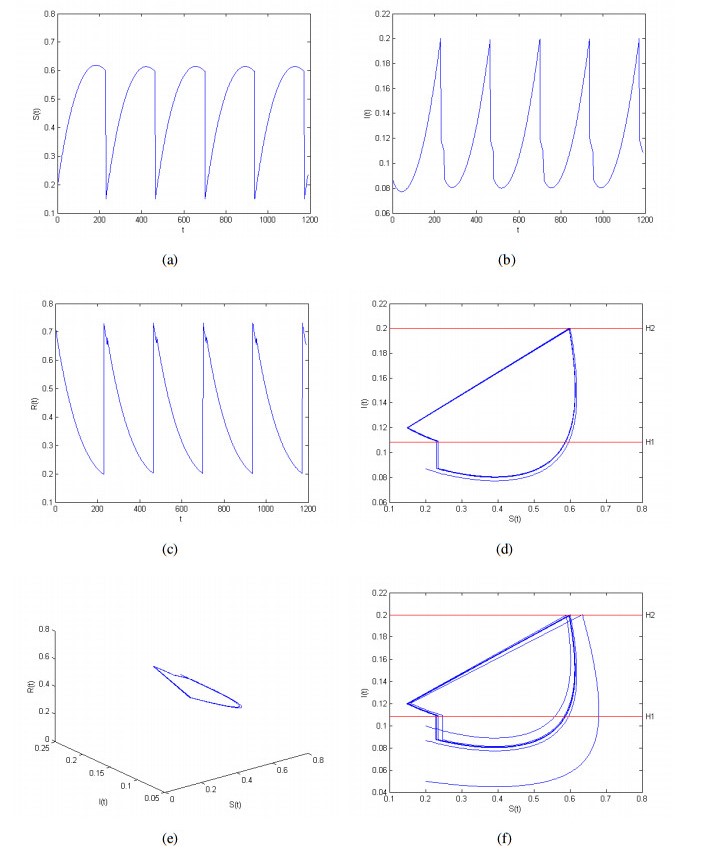









 DownLoad:
DownLoad:
